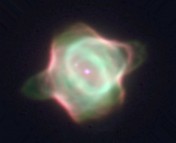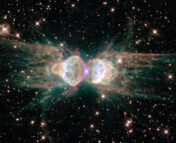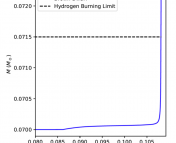• Title: Two short mass-loss events that unveil the binary heart of Minkowski’s Butterfly Nebula
• Authors: A. Castro-Carrizo, R. Neri, V. Bujarrabal, O. Chesneau, P. Cox, and R. Bachiller
• First Author’s Institution: Institut de Radioastronomie Millimétrique, France
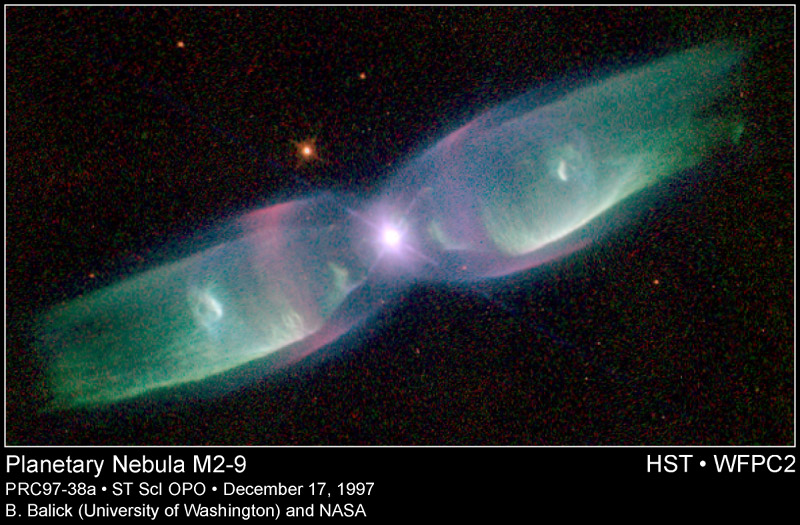
Figure 1: Optical image of the elongated structure of M 2–9. Note the two concentric sets of lobes emitted from the central source.
The Background
When asymptotic giant branch (AGB) stars cease their final rounds of nuclear fusion and ‘die’, they transition to become planetary nebulae (PNe). However, the details of this transition from an AGB star to a PNe are not well understood. One particularly troublesome mystery associated with the transition is the appearance of winds along the poles of some of these PNe, which disturb the expected spherical expansion of the gas, instead forming elongated structures such as those shown in Figure 1.
What causes these bipolar winds? A popular model suggests that they are triggered by the presence of a binary stellar system at the center of the nebula — the star that ‘died’ wasn’t alone.
Unfortunately, this theory is peskily difficult to confirm. Directly observing the star (or stars) at the center of a PN is very difficult, because it requires imaging through a very dense torus of gas and dust. The authors of this paper therefore use a somewhat less direct means to detect the presence of a binary system at the center of Minkowski’s Butterfly Nebula, or M 2–9 (pictured in optical in Figure 1).
Exploring M 2–9
Minkowski’s Butterfly Nebula is a young planetary nebula with a very elongated structure. Optical images of M 2–9 show two concentric sets of twin lobes of material, an inner and an outer shell, which expand outwards together. Until now, they were assumed to have been formed at the same time. M 2–9 is suspected of containing a binary system due to a changing pattern of knots that rotate about the nebula’s symmetry axis (see here for an animated gif) and could be explained by, for instance, a jet emitted by one member of the binary.
The authors of this paper use high-angular resolution interferometry to study carbon monoxide (CO) line emission within the obscured core of M 2–9, probing the mass distribution near this core. While this is not a new approach, the study in this paper was done at a higher angular resolution than previous studies.
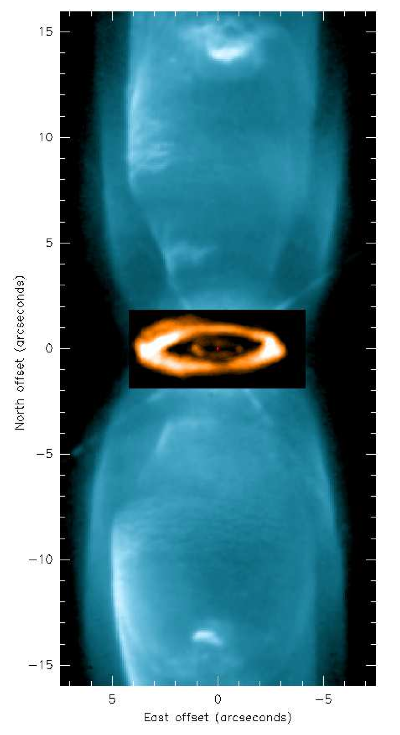
Figure 2: Optical image of M 2–9 with the carbon monoxide emission line data overlaid, showing the two concentric rings at the equator. The red dot at the center is the approximate position of the stellar system. Fig 2 from the paper.
Results
The authors found that the core of the nebula contains two concentric rings of gas and dust (see Figure 2). They rest in the plane of the equator of the nebula, and the inner and outer rings appear to be completely separated — which strongly suggests they were formed as a result of two entirely separate mass-expelling events. The authors postulate that the two concentric sets of optical lobes are counterparts to the concentric rings seen in CO emission, suggesting that each set of twin optical lobes was stimulated by a mass-loss event which also created an equatorial ring. This would imply that the lobe sets were created at different times, rather than both from the same event.
This is where this study gets interesting: the authors then analyzed the motions and spatial positions of the rings and were able to draw quite a few conclusions. From the size of the rings and their positions, they were able to determine that each mass-loss episode lasted ~40 years, and the two events were separated by ~500 years. Since the centers of the two rings are offset by ~0.3″, and their total velocities differ by ~0.6 km/s, the authors conclude that both the velocity and the position of the star that expelled the rings was different during the two mass-loss events. This is strong evidence in favor of a binary stellar system at the center of M 2–9: if the late-AGB star were circling a companion while it expelled mass in two separate events, the rings that formed would be offset from each other and moving at different speeds.
Making the assumption that the core of M 2–9 is indeed a binary system, and using the predicted orbital velocity of ~90 years that was determined from the precession of the knots in the nebula, the authors further pin down the characteristics of the system, including a mass estimate for the companion star of ≤0.2 M_sun. They postulate that the companion is a dwarf, and that it’s responsible for the jets that cause the moving knots within the nebula.
Conclusion
Despite the limitations on what can be directly imaged at the center of planetary nebulae, these authors have demonstrated that it is still possible to learn a lot about what’s happening there indirectly. They’ve shown reasonably conclusively that a binary stellar system is present at the center of M 2–9, and they’ve determined many of the system’s characteristics using clever modeling. This work puts in place an interesting piece of the puzzle of PNe formation, and helps us to further understand the process of how these structures are formed and evolve.

